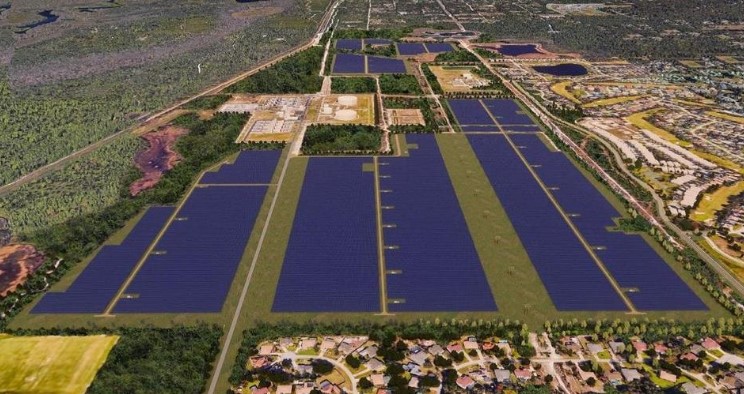
Within a couple of years, residents could turn on their TVs or switch on a light powered by solar energy.
At least that’s the goal at Duke Energy Florida.
The utility company has filed an application to amend a development agreement with the city and plans to build a solar power plant on about 350 acres at 176 W. Highbanks Road, adjacent to the current Duke Energy plant.
“This is about as green as it gets,” said Roger Van Auker, DeBary’s transit-oriented development marketing director. “I think it’s a great use for the land.”
The solar plant will be comprised of 300,000 fixed-tilt solar panels, the company said. Once it’s up and running, producing nearly 75 megawatts of electricity, the plant will be able power about 20,000 average-sized homes at peak production.
The project is expected to cost at least $70 million and create more than 100 construction jobs, said Tom Lawery, Duke Energy’s wholesale renewables manager.
“Duke Energy will file a request with the Florida Public Service Commission to review the actual investment costs associated with the DeBary solar power plant, most likely in 2019,” Lawery said.
Construction considerations
The utility is looking to start construction during the first quarter of 2019 with a completion goal of December 2019.
While the construction will generate some noise, area residents shouldn’t expect to hear much once it’s done since solar plants generate power with few, or zero, moving pieces.
The inverter/transformer pads will create a small amount of noise, but the equipment will be put at the site’s interior so it’s virtually inaudible to residents who live nearby, according to Duke Energy. The plant also will comply with DeBary’s noise ordinances.
Lawery said the number of construction workers, all of whom will undergo background checks and drug screening, will fluctuate throughout the process.
Before construction even begins, Duke Energy will have studies performed to find out what, if any, the impacts would be to wildlife and the environment and what mitigation work may be needed, Lawery said.
Pat Wentworth, who lives near the intersection of West Highbanks and Gracie roads, said she’s a little concerned about the amount of construction vehicles it’ll bring to the two-lane road, but otherwise she’s interested in learning more about the benefits of solar power and how it may affect her utility bill.
“Certainly it’ll be good for the environment,” Wentworth said.
Solar goals
If all goes according to plan, the DeBary solar plant would account for approximately 10 percent of the 700 megawatts of solar power Duke Energy Florida is looking to build or obtain by 2022.
By 2017, the company had completed three universal solar power plants, which are located in Osceola, Taylor and Suwannee counties.
“Customers expect us to deliver electricity that is reliable, increasingly clean and more secure, while also providing more value and options every single day,” Catherine Stempien, president of Duke Energy Florida, said in a news release. “We’re working to accomplish these critical goals by making investments to build a smarter energy future.”
A solar plant the same size as the one proposed for DeBary is under construction in Hamilton County, and Duke Energy is planning another solar project of the same size in Columbia County.
“Pursuit of large-scale solar, electric vehicles and battery storage are positive steps for our energy grid and the Sunshine State,” Stephen A. Smith, executive director of the Southern Alliance for Clean Energy, said in a news release. “We welcome Duke Energy’s willingness to work with stakeholders on data collection and any rate design changes impacting customer-owned demand side solar.”
